(26-03-23) Blog 85 – Protecting your online activity – Pt5
What’s on your network?
Whilst I understand that not everyone is a computer geek, or has the time to manage their home network properly, I firmly believe that everyone should have a good grasp on what is running on their network.
To discover what’s on your network there are a few things you can do, and in this post, I’ll detail some of those options.
Manage your IP addresses
Devices can only communicate on your network if they have an IP address, so the first thing to do is work out which devices have which IP address – that way you’ll know what is what and be able to manage things more effectively.
Management of IP addresses is typically done with DHCP – Dynamic Host Configuration Protocol, and whilst this process is pretty much self-managing, there are things you can do to make it better.
Check your router
For most people, DHCP is something which your home router just does, and as such, most people never explore what their options are.
Not every home router is the same, and if it’s an ISP provided one, there may not be a huge range of options, but they are worth exploring none the less.
My home ISP router is provided by Virgin Media, and to be completely honest – it’s useless. Virgin for whatever reason, have decided to remove most of the useful configuration capabilities from their router, the screen shots below show what few features are still available.
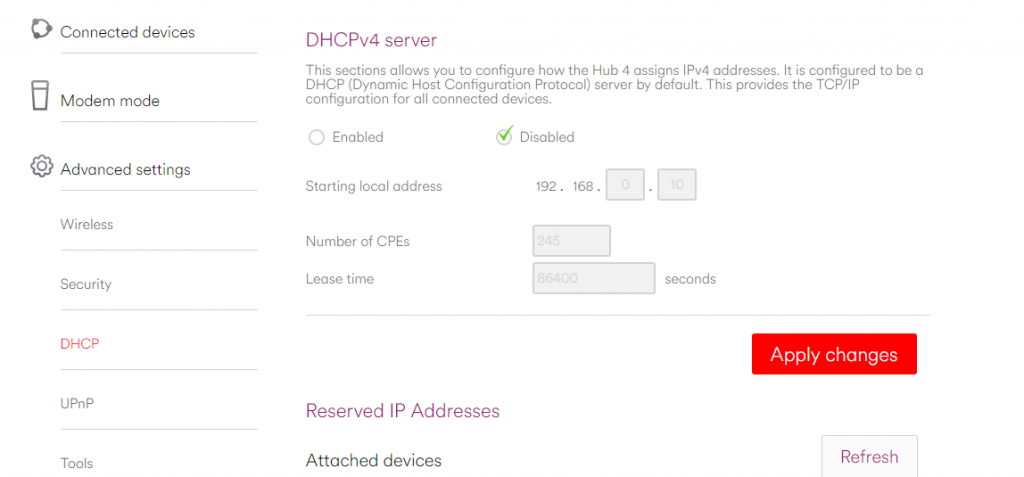
As you can see, the Virgin Media router give me options for enabling or disabling DHCP. When enabled, there are no options to set any reserved IP addresses, and no options to use other IP ranges such as the 10.0.0.0 range.
Additionally, for some strange reason, the router only allows for 245 CPEs (Customer Placed Equipment) – Why? Again, I have no idea.
I have no idea why Virgin place these limitations on their equipment, but I’m sure some highly paid executive in Virgin’s IT team had to justify their salary and came up with a really good reason for it all.
For me though, the fact that Virgin Media have chosen to block customers from specifying a DNS server in the DHCP options is my biggest issue. This is why I have chosen to disable the routers DHCP option and use the DHCP service offered by my pi-hole.
If you’ve been following my posts you’ll know how much of an advocate of this I am. Check out my earlier posts on the pi-hole to see what it can do for you if you haven’t read them yet.
- Blog 4 – Blocking ads and more with a Pi-hole
- Blog 5 – Pi-hole, post install activities
- Blog 6 – Blocking those pesky ads
- Blog 7 – customising your pi-hole
- Blog 8 – analysing your data
- Blog 9 – Changing your view
- Blog 10 – Enhancing the Pi-hole
- Blog 11 – installing a VPN
Identifying devices
Another gripe of mine with the Virgin Media router is its inability to use standard protocols to try to determine the host-names of connected devices.
I have a fairly busy network with all sorts of devices connected, PC’s, phones, laptops, Smart home devices (plugs, bulbs, hubs, etc.) yet Virgins router can only actually determine one of the 40 devices it can see.

So, rather than live with a ton of “unknown” devices, I have taken the time to manually identify each device I have in my network and give them meaningful names in my pi-hole DHCP admin page.

These names are visible in the pi-hole and it makes it easier for me to see which device is which, but also, in the case of many devices, which room of the house they are situated.
If you want to identify the devices, but not have to do it manually like I have, then there is another option.
Fing
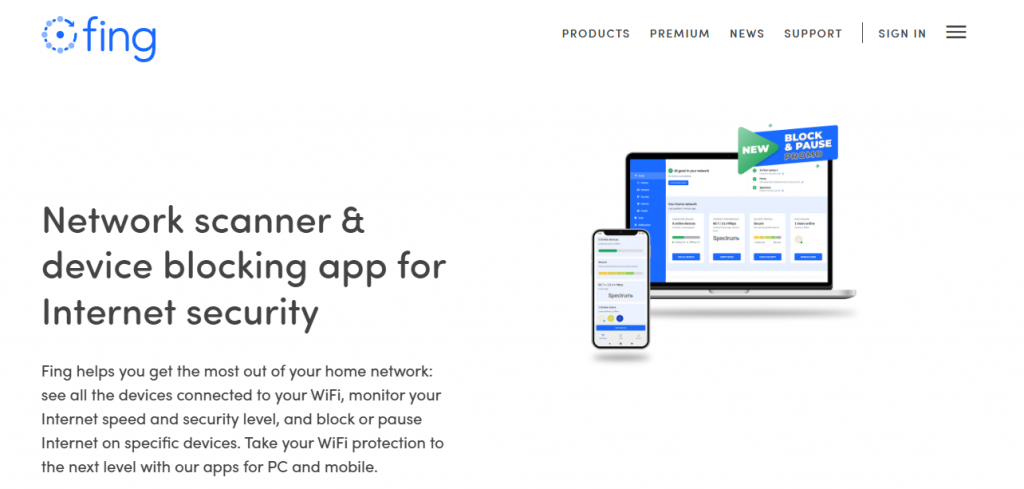
Fing is a utility which is owned by a company called Lansweeper and is quite similar to their commercial platform which they released a number of years ago.
Fing is available as a mobile app, a PC desktop utility, and a network hardware device – known as fingbox.
The mobile app and desktop utility come in 2 versions – a free version, and a premium version which has a $4.99/mth subscription model.

For many people, the free version will be enough to get an idea what is on their network, and other data such as network capacity, performance, etc.
Fing capabilities
Once you have downloaded & installed the Fing app, and created an account, you will be presented with a dashboard that shows you an overview of your network, the devices & users online, and some other elements such as broadband speed, and security issues.
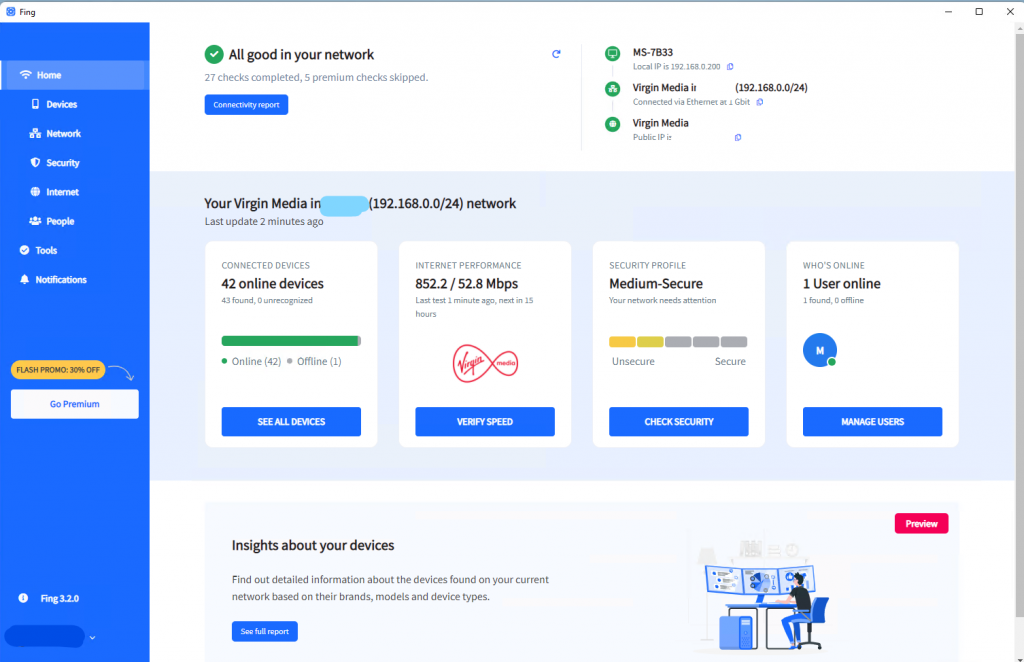
Discovered devices
Selecting the devices option will open another page where you can see detailed information about the devices which Fing has discovered. in my case, Fing not only shows the names I give my devices via my pi-hle, but their actual hostnames (Virgin Media take note- see, it can be done!)
Fing also shows other characteristics of the devices such as the operating system of the device, whether it is connected via Wi-fi, if it is a voice activated device, or if the device is a camera.
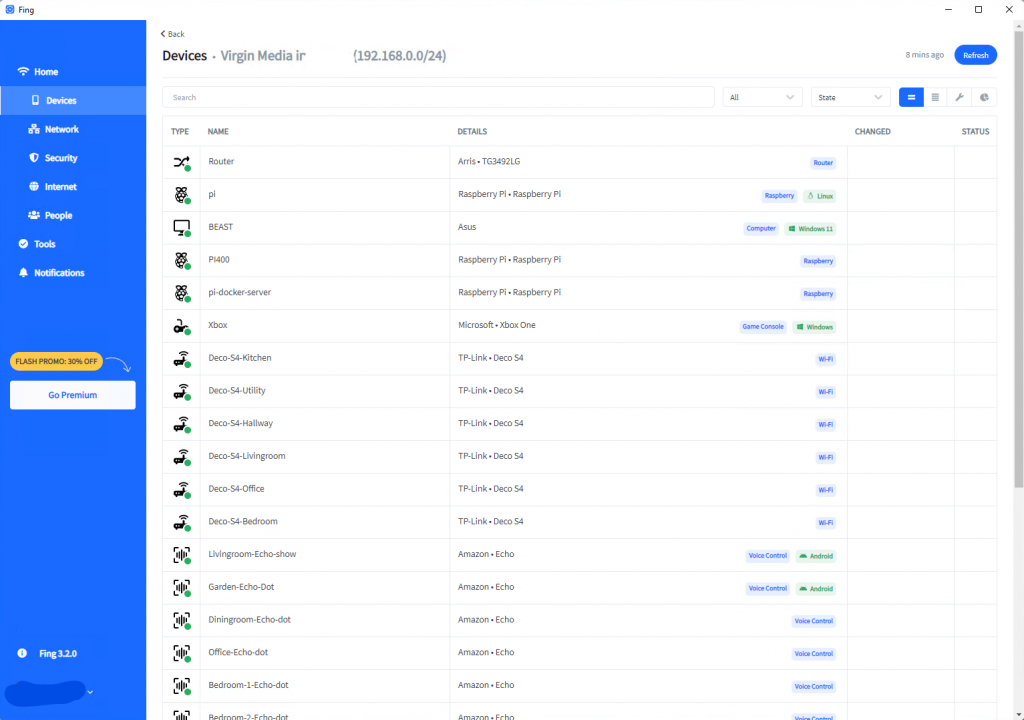
Each device shown in the list can be explored in detail by simply clicking the appropriate device.

Network
The network option of Fing shows you some data about your current home network, but also your ISP network.
There is an option to allow Fing to do weekly deep scans of your network to discover new devices, etc.

Security
The security option is the least useable portion of the free version of the Fing app, but it gives you an idea on what the premium options are and whether you would want to purchase the subscription.

Internet
The Internet page allows you to perform speed tests on your broadband connection and shows how your network compares to others in your locale.
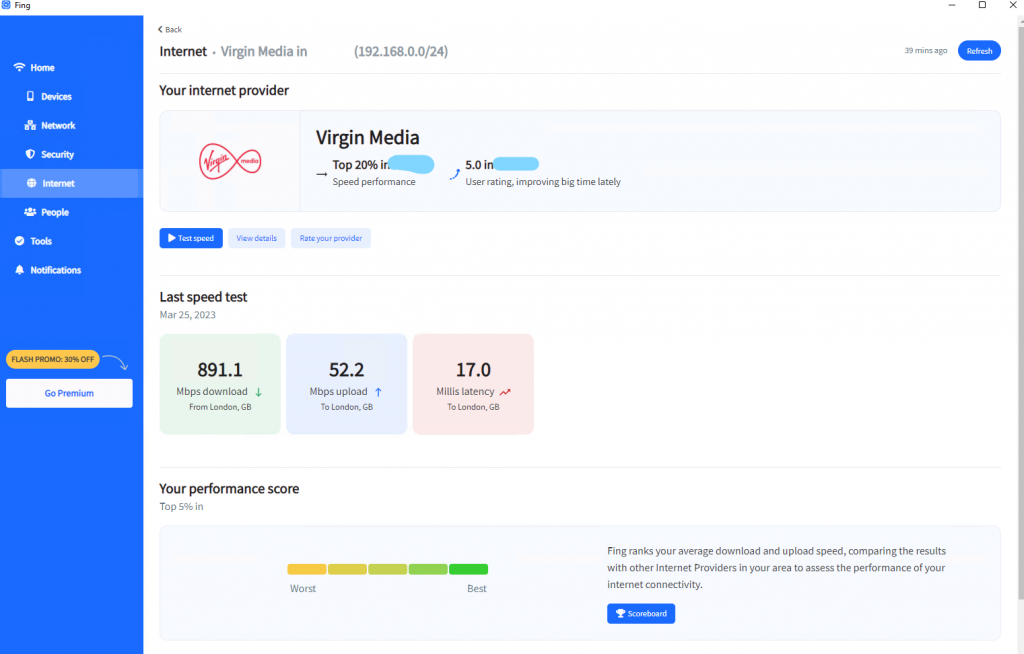
People
The people page allows you to track the presence of people coming and going from your network by detecting their devices as they join & leave your network.
The free version of Fing is limited in the usefulness of this feature, but the premium version allows you to receive notifications – this can be useful to give you alerts when children come and go from your house by detecting their mobile phones.
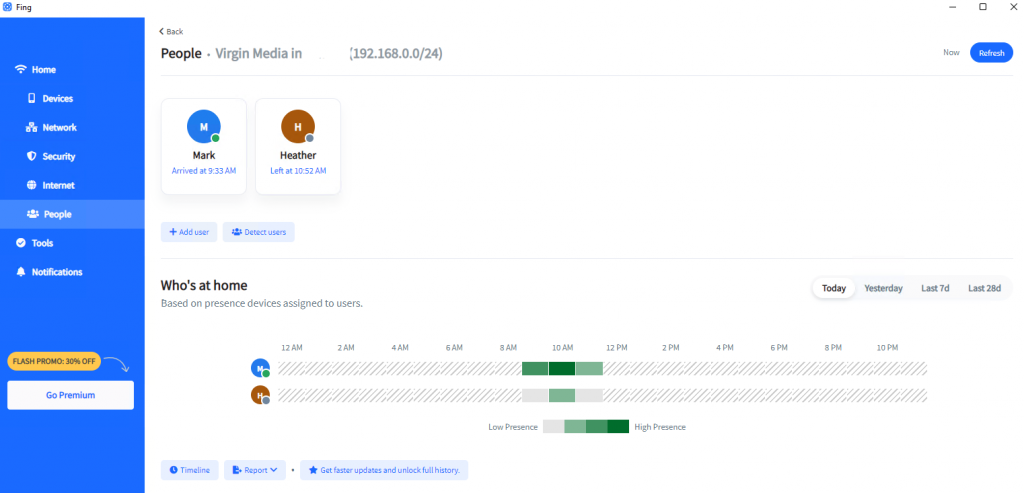
Tools
The tools page gives you a handy place to run different scans and probes across both your home network, but also the Internet.
The troubleshooting tools are all things which you can run manually via a CMD prompt, but for many, this is too complex to do, so the fact that Fing has all these tools collected in one handy place is ideal.
The wi-fi scanner tool is more useful run via the mobile version of the app rather then the desktop version as you can move around your house looking for weak signal spots.
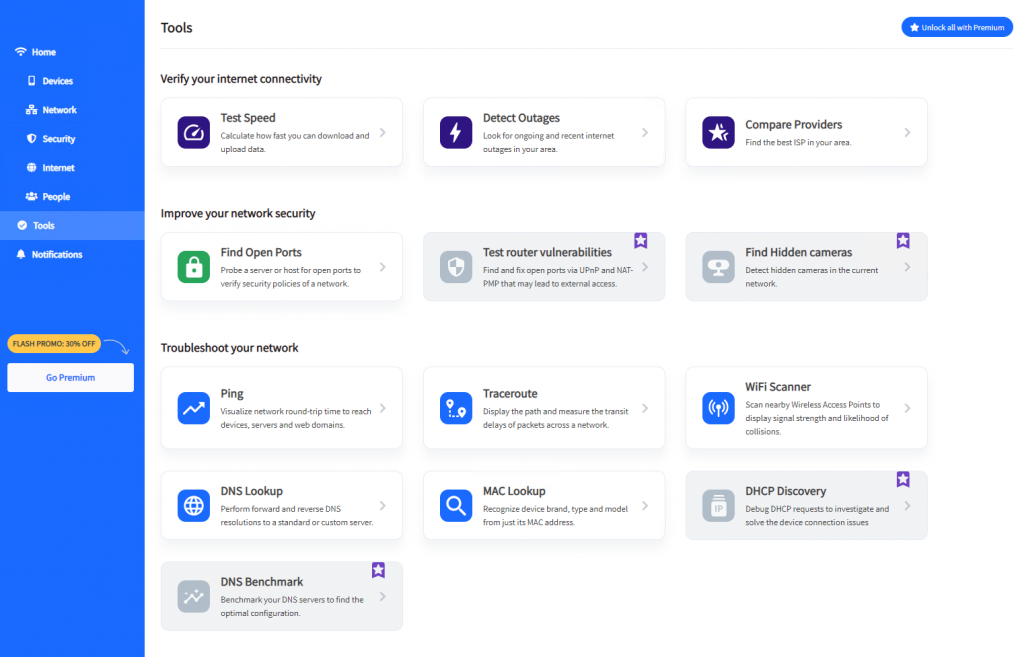
Fingbox
The fingbox hardware device gives you all of the same capabilities as the Fing app, but it also acts as a gatekeeper to your network allowing or blocking devices from even accessing your network.
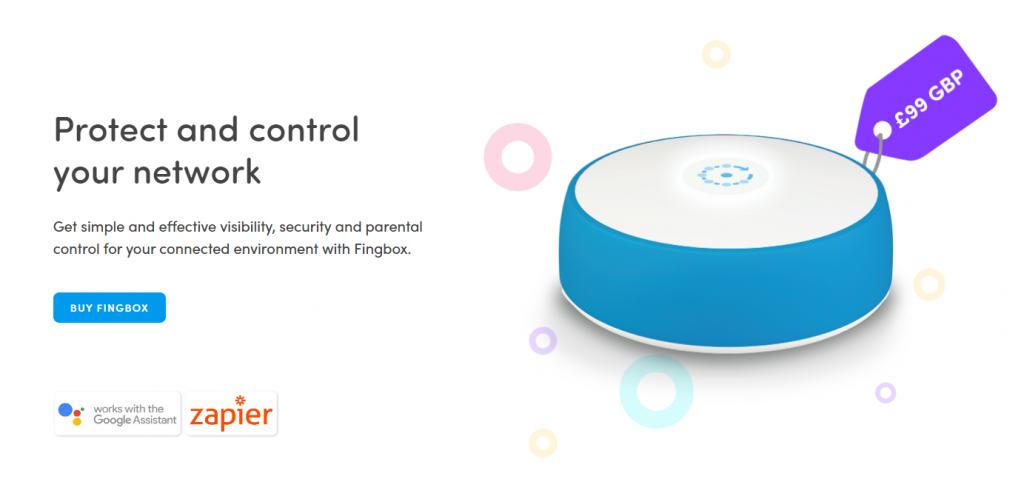
Internet downtime
A handy feature of the Fingbox is its ability to use schedules to block certain devices from accessing the Internet. This can be handy if you have young children who find it difficult to tear themselves away from the games console, or mobile phone when they should be doing homework, or getting ready for bedtime, etc. If the Internet is not available for them, then there’s less of an opportunity for distraction.
Final thoughts
There are many different ways to detect and manage devices on your network.
For the techy ones, nmap and Wireshark offer some great solutions, but these tools really aren’t for the average Joe to use – so things like the pi-hole and the Fing app make it much easier for non-techy people to get a grip of their ntwork security.
Whatever approach you take, so long as you are doing something it will give you a better view of your networks security and performance.












